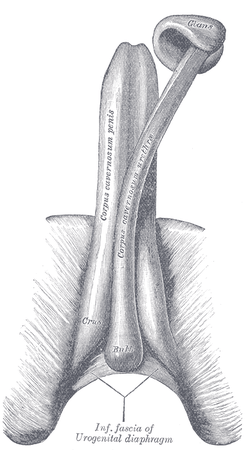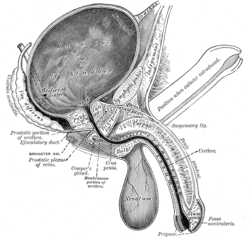Body of penis
The body of the penis extends from the root to the ends of the corpora cavernosa penis, and in it these corpora cavernosa are intimately bound to one another with a dorsally fenestrated septum which becomes a complete one before penile crura.[1]
| Body of penis | |
|---|---|
 The constituent cavernous cylinders of the penis. | |
 Vertical section of bladder, penis, and urethra. | |
| Details | |
| Identifiers | |
| Latin | corpus penis |
| TA | A09.4.01.003 |
| FMA | 18249 |
| Anatomical terminology | |
It is surrounded by a bi-layered model of tunica albuginea in which a distal ligament buttresses the glans penis and plays an integral role to the penile fibroskeleton, and the structure is called "os analog," a term coined by Geng Long Hsu in the Encyclopedia of Reproduction.[1] This indispensable structure is a continuation of the body of human penis, differing from other mammalian penis, in that it has no baculum (or erectile bone) and instead relies exclusively on engorgement with blood to reach its erect state. It is a remnant of baculum evolved likely due to change in mating practice.[2]
A shallow groove which marks their junction on the upper surface lodges the deep dorsal vein of the penis which is flanked by a pair of cavernosal veins of the penis,[1] while a deeper and wider groove between them on the surface below contains the corpus spongiosum-corpus cavernosum urethræ. The body is ensheathed by fascia which includes tunica albuginea, Buck's fascia, dermis, and skin (i.e. ABCDs in acronyms).
Additional Images
- Body of penis
- Body of penis
References
- Hsu, Geng-Long; Liu, Shih-Ping (2018). "Penis Structure". Encyclopedia of Reproduction. pp. 357–366. doi:10.1016/B978-0-12-801238-3.64602-0. ISBN 9780128151457.
- "Why Humans Lost Their Penis Bone". Science.
This article incorporates text in the public domain from page 1249 of the 20th edition of Gray's Anatomy (1918)